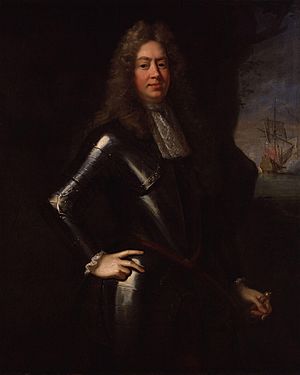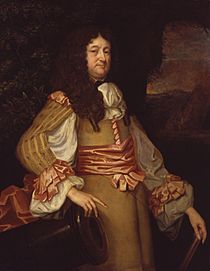George Legge, 1st Baron Dartmouth facts for kids
Quick facts for kids
The Lord Dartmouth
|
|
|---|---|

George Legge, 1st Baron Dartmouth
|
|
| Admiral of the Fleet | |
| In office 24 September 1688 – 10 January 1689 |
|
| Lord Lieutenant of the Tower Hamlets | |
| In office June 1685 – December 1688 |
|
| Constable of the Tower | |
| In office June 1685 – December 1688 |
|
| Governor of Tangiers | |
| In office September 1683 – February 1684 |
|
| Master-General of the Ordnance | |
| In office 1681–1689 |
|
| Member of Parliament for Portsmouth |
|
| In office February 1679 – February 1685 |
|
| Governor of Portsmouth | |
| In office 1673–1682 |
|
| Member of Parliament for Ludgershall |
|
| In office February 1673 – January 1679 |
|
| Personal details | |
| Born | c. 1647 London |
| Died | 25 October 1691 (aged 44) Tower of London |
| Resting place | Church of Holy Trinity, Minories |
| Nationality | English |
| Spouse | Barbara Archbold (m 1667-1718) |
| Children | William (1672-1750); Mary (died 1753); Six other daughters |
| Alma mater | King's College, Cambridge |
| Occupation | Naval officer |
| Military service | |
| Years of service | 1667–1689 |
| Rank | Admiral |
| Commands | HMS Pembroke; HMS Fairfax; HMS Royal Katherine; |
| Battles/wars | Second Anglo-Dutch War Four Days' Battle Third Anglo-Dutch War Solebay; Schooneveld; Texel Glorious Revolution |
George Legge, 1st Baron Dartmouth (born around 1647 – died 25 October 1691) was an important English Royal Navy officer. He was made Admiral of the Fleet by King James II of England in September 1688. However, he was unable to stop a Dutch invasion force led by William III from landing in England. This event led to the Glorious Revolution, and Legge was later removed from his position.
Early Life and Family
George Legge was born around 1647 in London. He was the oldest son of Colonel William Legge and Elizabeth Washington. His father, Colonel Legge, was a close friend of Prince Rupert of the Rhine. He fought for the King's side (the Royalists) during the Wars of the Three Kingdoms. He was arrested several times for trying to bring King Charles II back to power. After Charles II became King again in 1660, his father was given an important job as Lieutenant-General of the Ordnance. He held this role from 1660 to 1670.
George had a younger brother named William (born around 1650). William later became a MP for Portsmouth in 1685. His sister, Mary (1647-1715), married a diplomat and politician named Sir Henry Goodricke.
In November 1667, George Legge married Barbara Archbold (1650–1718). She was the daughter of Sir Henry Archbold. George and Barbara had one son, William (1672-1750), and seven daughters. One of his daughters, Mary (died 1753), married Sir Philip Musgrave. Sir Philip also worked under Legge as Lieutenant-General of the Ordnance.
George Legge studied at Westminster School and King's College, Cambridge. He started his naval career during the Second Anglo-Dutch War. In 1666, he volunteered to serve under his cousin, Admiral Sir Edward Spragge, in the Four Days' Battle. Because of his family connections, he became a Captain at age twenty in April 1667. He commanded HMS Pembroke, a 28-gun ship. Sadly, the ship sank on 11 May after crashing with HMS Fairfax near Torbay.
Even with this difficult start, he was appointed Groom of the Chamber to the future King James II in 1669. In January 1672, he was given command of HMS Fairfax. In March, he took part in an attack on a Dutch merchant ship convoy in the Channel. This attack helped start the Third Anglo-Dutch War. In June, he fought in the Battle of Sole Bay. The next year, he commanded HMS Royal Katherine under Prince Rupert of the Rhine in the Battle of Schooneveld.
By 1683, Legge had become an Admiral. He was sent to Tangier with Samuel Pepys to manage the removal and destruction of the English settlement there. His last naval job was commanding a fleet in the Channel. This fleet tried to stop the invasion force led by William III of Orange in 1688. This invasion marked the start of the Glorious Revolution. In the same year, he was named the first Admiral of the Fleet.
Later Life and Death
After King James II left the throne, William III removed Dartmouth from his positions. In July 1691, Dartmouth was imprisoned in the Tower of London. He passed away in the Tower a few months later, on 25 October 1691. He was never put on trial. He was buried in the church of the Holy Trinity, Minories, in London, just like his father. His only son, William Legge, 1st Earl of Dartmouth (1672–1750), became the next Baron Dartmouth.
Images for kids
-
Colonel William Legge (1608-1670)



